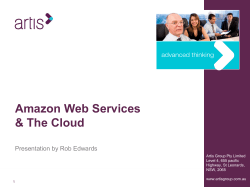
Enterprise IT: A year that was and expectations from 2015
Enterprise IT: A year that was and expectations from 2015 by C. Vijay Kumar, December 12, 2014 As we wind down 2014 it’s extremely important to retrace the important trends that changed the face of enterprise computing. Year of De-mergers: Sharper focus on businesses and dire need to innovate saw a significant trend that played out this year, three big global technology firms announced breakups. Hewlett-Packard and Symantec are both dividing their operations in two, while eBay is spinning off PayPal—all dramatic changes of direction. Cloud Computing & SaaS: Enterprises continued to adopt Public Clouds for selective workloads and explore new workload development in the cloud. Enterprise IT teams are showing interest in learning and adopting from large online hyper scale & webscale organizations like Facebook and Google. On the other hand MS Azure has emerged as a serious threat to Amazon and Google. For example Microsoft CEO has always been vocal about his “cloud-first” strategy, and made it clear that Azure, Microsoft’s cloud service platform, was a serious player in the field. Certain SaaS solutions have become defacto standards for Enterprise IT in specific areas like Horizontal Business apps, Digital Marketing, Office Productivity, Enterprise & IT Service Management etc. SDDC and Openstack: SDDC is a Data Center architecture that is defined and controlled using software concepts and enabled by virtualization of various Infrastructure components such as Compute, Storage, network and security. The SDDC concept is also propelling DevOps culture / discipline into Enterprise IT, as software defined and API driven solutions enable and accelerate adoptions of such concepts. As far as Enterprises go, they are adopting wait and watch strategy as these solutions evolve and mature. Openstack adoption in enterprises has been limited. While organizations continue to do pilots, the support of the platform continues to be a problem area. Interesting discussions have started on use of unbranded / low cost hardware within enterprises IT architecture and design. Workload Engineered Systems are seeing increased adoption in large enterprise for workloads around Databases, Analytics and select Application Servers. DevOps: The buzzword this year was Devops, an emerging IT practice of more tightly integrating the development cycle of an application with the subsequent operation of that application. It can cut the length of time it requires to update a customer-facing or internal application. Enterprise IT has also started showing interest in this area lured by the promise of agility and faster time to roll out business services. 2015 Outlook As we look forward to 2015, disruptive technologies are going to ensure that IT leaders not only accelerate the transition to next-generation infrastructure, reduce risks, but also improve organizational execution. The year ahead is slated to be a challenging one but with new opportunities for the growth oriented companies. Some of the key trends to look forward are: New emerging technologies The buzz word for 2015 is likely to be agility. Enterprises will be looking at evaluating and adopting several new technologies/concepts and framework to bring in agility, efficiency and intelligence within their environments including DevOps & IT Operational Analytics/Autonomics to name a few. Big Data will remain an interesting area for adoption; however enterprises will struggle with talent in this area. CIOs are likely to look at ways and means to harness the IOT for business growth. Security and GRC will continue to be top of the agenda for the year with increase in hyperconnected deployment of application and services. Maturing SDDC Market We expect SDDC to mature and become part of strategy roadmap for every CIO. As customers are moving towards adopting a Cloud model, SDDC will play a pivotal role. SDDC will hugely help in automation and improving IT agility for customers who are looking to adopt the Cloud model. Some of the verticals that would be early adopters of SDDC, may include:-Banking, retail, media and entertainment. Workplace Modernization We expect significant adoption of diversified platforms in the Personal computing space cutting across hybrids, smartphones, tablets with significant leverage of Cloud Services around Office Productivity, Collaboration and Mobility applications. Introduction of Personal Cloud for End Users with User Profile Centric Services will see adoption in the coming year. Year of Partnerships New partnerships and alliances are all set to drive the OEM market based on OEM strategy and growth plan. This may involve some significant acquisitions and/or mergers/demergers. The Systems Integrator partnerships landscape will also evolve in the coming year with consolidation of portfolio and emergence of new ecosystems across products and services. Role of CIOs Security issues will continue to concern CIOs, especially on cloud. This fear will elevate as other technologies get into enterprises like wearables, BYOD, IOT etc. the CIO role will evolve into leveraging Service Integration at the core of the Operating Model to allow Multiple Service Providers, Cloud Providers and Outsourcers to operate in a cohesive and collaborative manner to deliver Business Outcomes. With significant adoption of Digitalization expected in the coming years, Outside In innovation will be the key lever for CIOs to leverage to drive Competitive advantage for their business. Copyright © 2014 UBM India, All rights reserved
© Copyright 2025
















